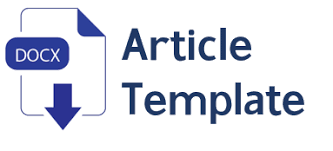AUTHOR GUIDELINES
The Guidelines for the Manuscript Body Text
- We accept articles with the following types:
- Research Paper
- Literature Review
- Case Study
- Book Review
- General Guideline
- Article has never been published before
- Results-based research is prioritized for publication
- The article consists of 10-15 pages without references and it must be written in A4 paper, Geramond 12, Space 1.15, Margin of 3 for top, bottom, left and right sides.
- The article has no typos
- The article has plagiarism
- The articles are written in the form of essays in which it has no dot points and numbering
- It does not use footnote or endnote, but running note (surname, year of publication)
- Title
- The title is written in the language; namely Indonesian or English
- Titles in Indonesian or English must not exceed 14 words
- The title must state the research results
- There should be no subtitles
- Title written in Geramond 14, Bold, Left Aligned
- The title is written with the first letter in capital letters
- Name of Author and Institution of Author
- The author’s name is completely written without academic title or indication of position and stratification
- The name of institution is completely written
- Correspondence must include email
- 5. Abstract
- Abstract is written in dual languages, those are Bahasa Indonesia and English
- Abstracts must be written in a maximum of 250 words in Indonesian and English
- Abstract must be written in one paragraph only encompassing background, purpose of the study, methods, results and conclusion
- Keyword
- Keyword must be written in dual languages, those are in Bahasa Indonesia and English
- There must be at least three keywords in the abstract
- Introduction
- Introduction consists of background, purpose of the study and research urgency
- Statement of the problem and/or hypothesis must not be written in the form of subheading but research question which is integrated in paragraph, part of the introduction.
- Methods
- Practical methods
- It consists of research type/approach, location, population and sample, sampling drawing techniques, data collection techniques and data analysis techniques.
- Results of the study
- All tables, graphics and figures are thoroughly discussed, placed in the centre and appropriate interpretation are highly desirable (description is not repetitive from tables, graphics and figures)
- Tables use three horizontal lines
- Tables and graphics are made in the format of MS Word/Excel
- Every table consists of table number and table title written above the table
- Every graphic/picture consist of graphic/picture number and title written below the graphic/picture
- Conclusion
- Conclusion does not repeat what has been discussed in results section
- Contains research findings. It should answer research goals and give applicative recommendations. Moreover, it must be written in a paragraph without numbering
- References
- References written must be cited in writing and vice versa
- Book citation is at least from last 10-years publication, whereas, for journals, it is at least from last 5-year publication.
- Follows the American Psychological Association (APA) 6th Edition
- References consist of primary sources (scientific journals, research report or conference proceeding and the least number is 80% from all the references.
- Each article should has at least ten references
- Authorship
- Filling in the statement form of responsibility upon all content of the article
- Signing the statement that the article is not being proposed to another journal and it will not be submitted to another journal during the editing and reviewing.
- Signing the statement of plagiarism free
- Editorial staff has the right to edit the article without changing the content and the main idea of the author.











